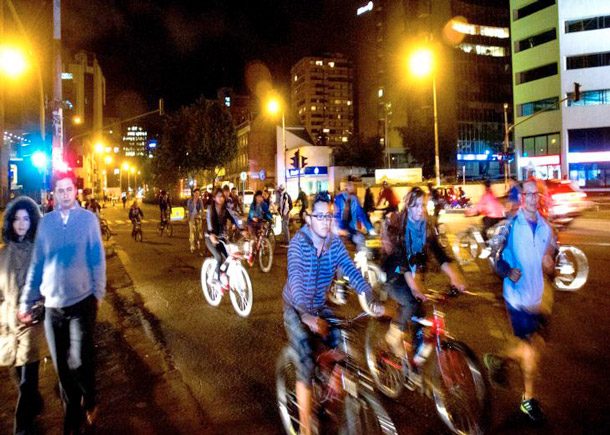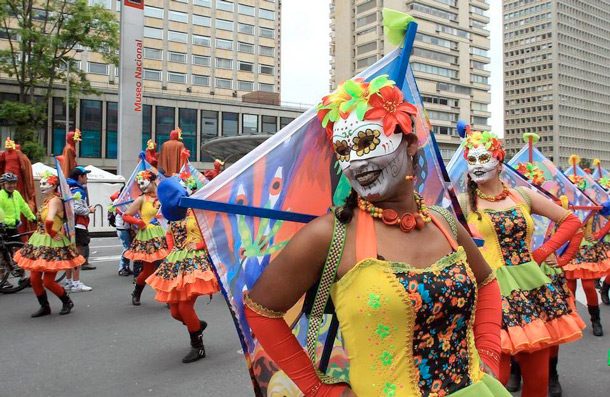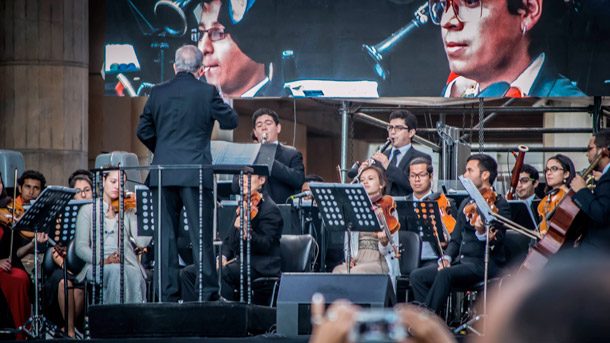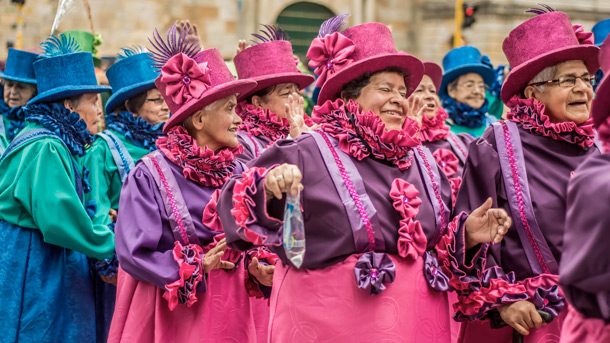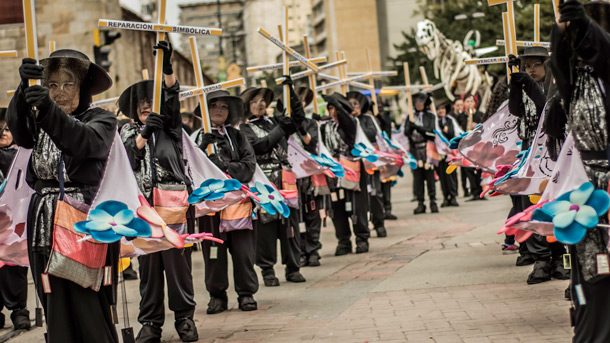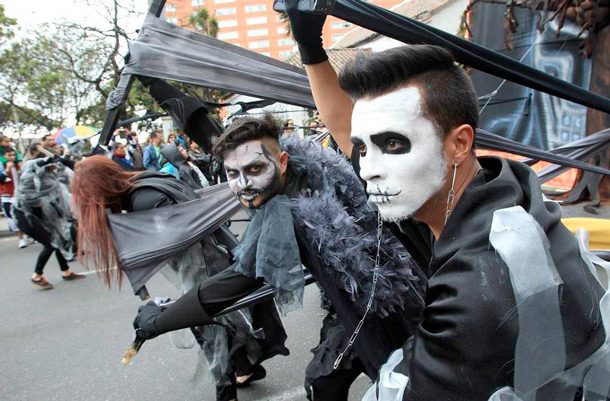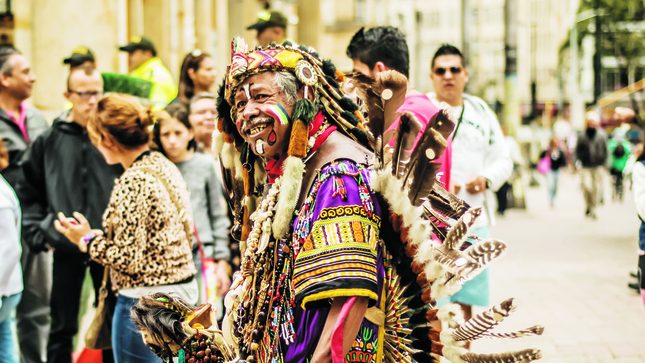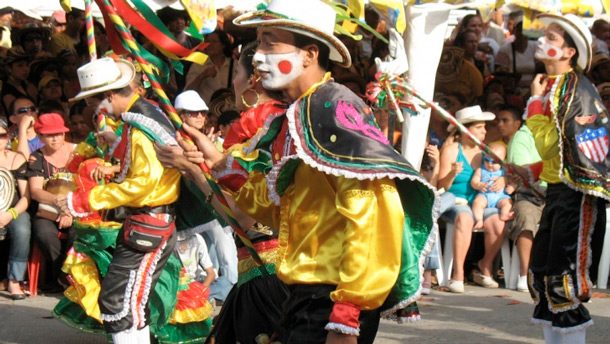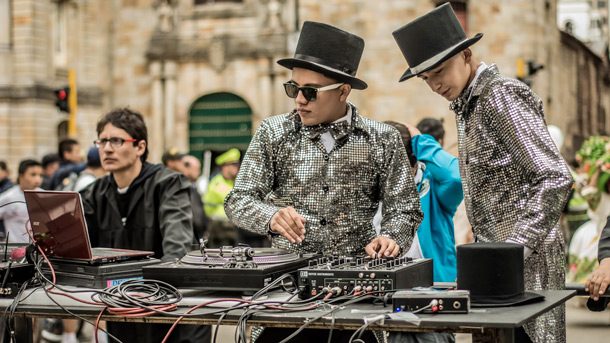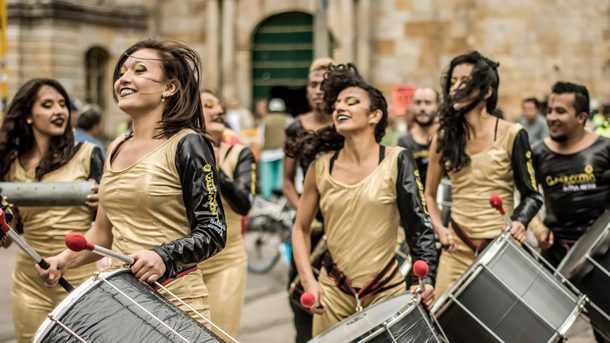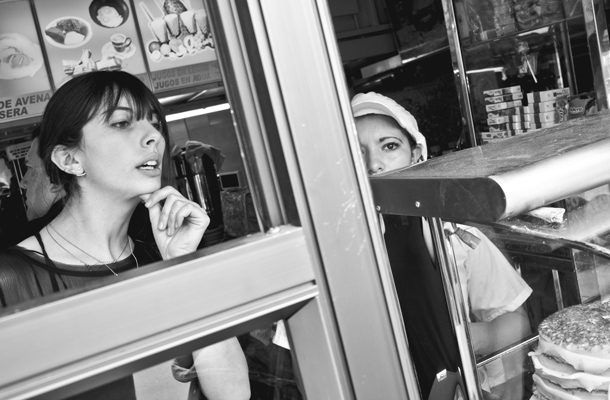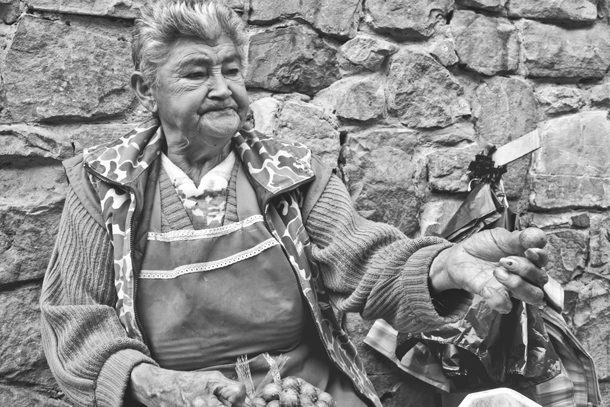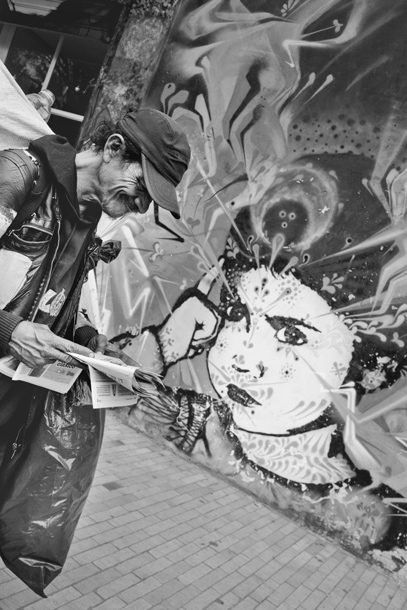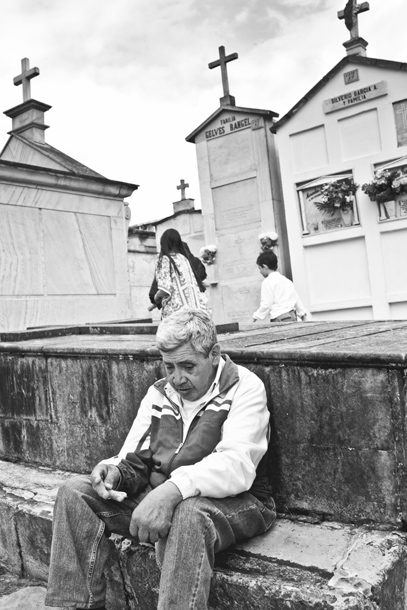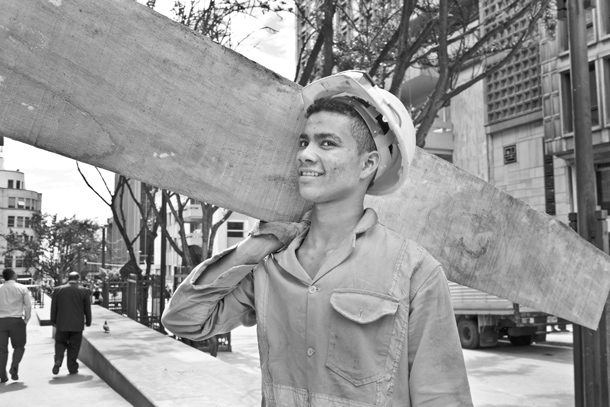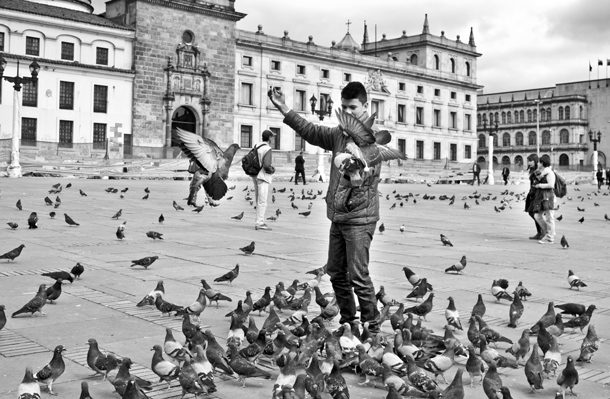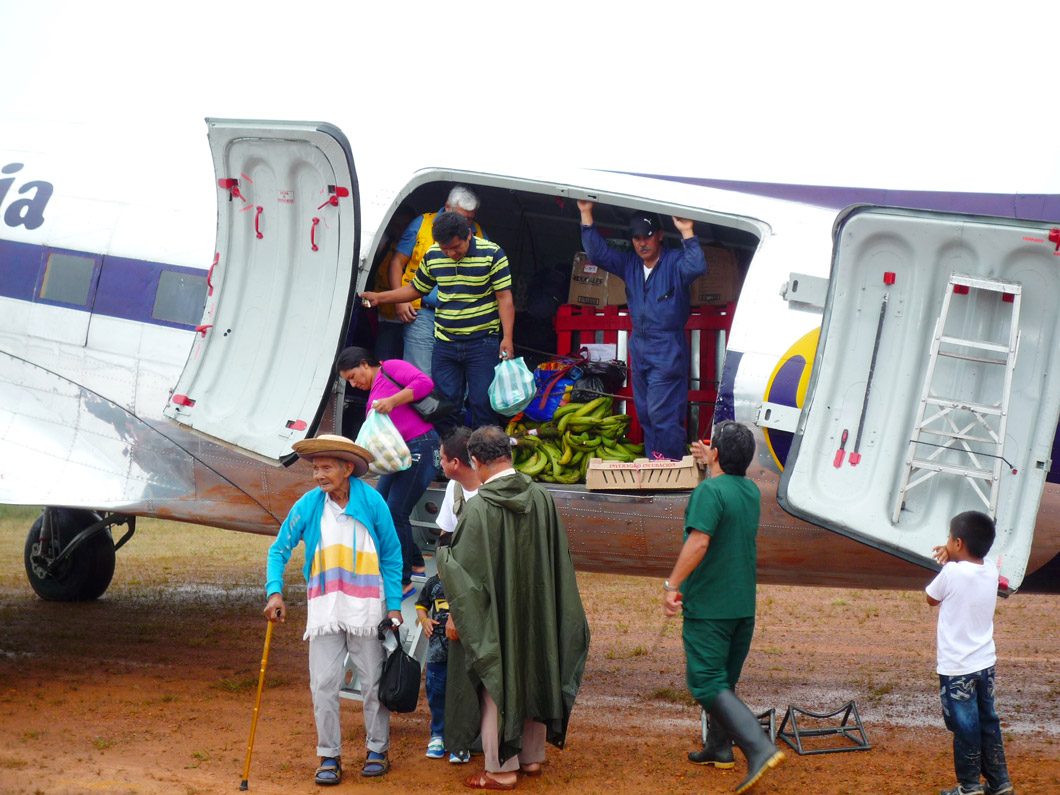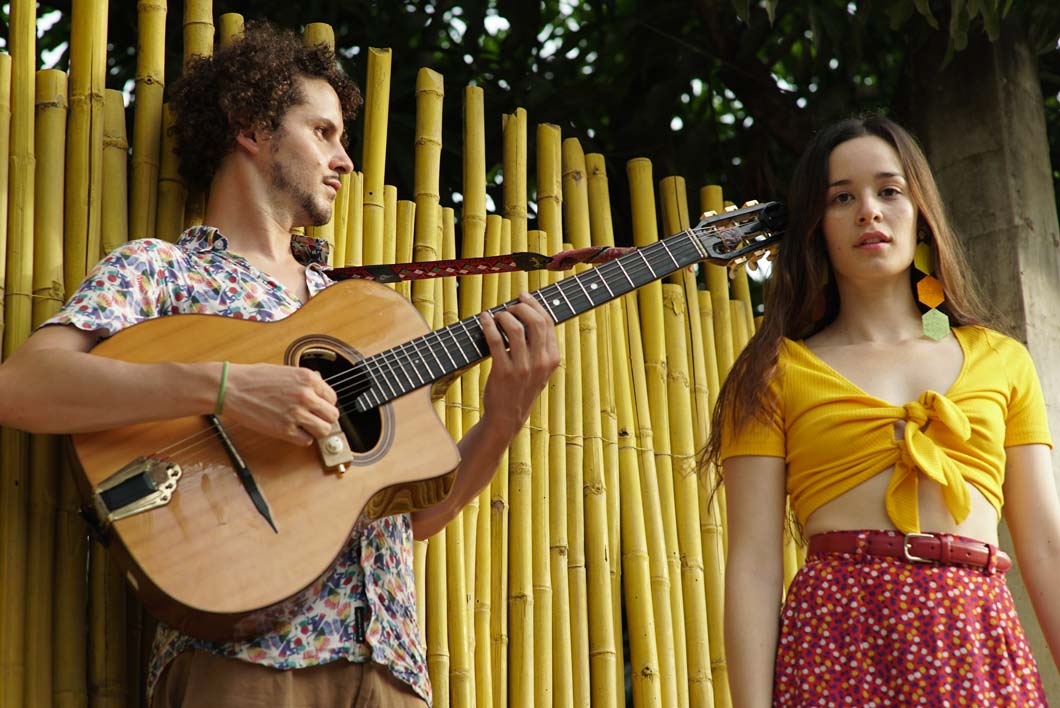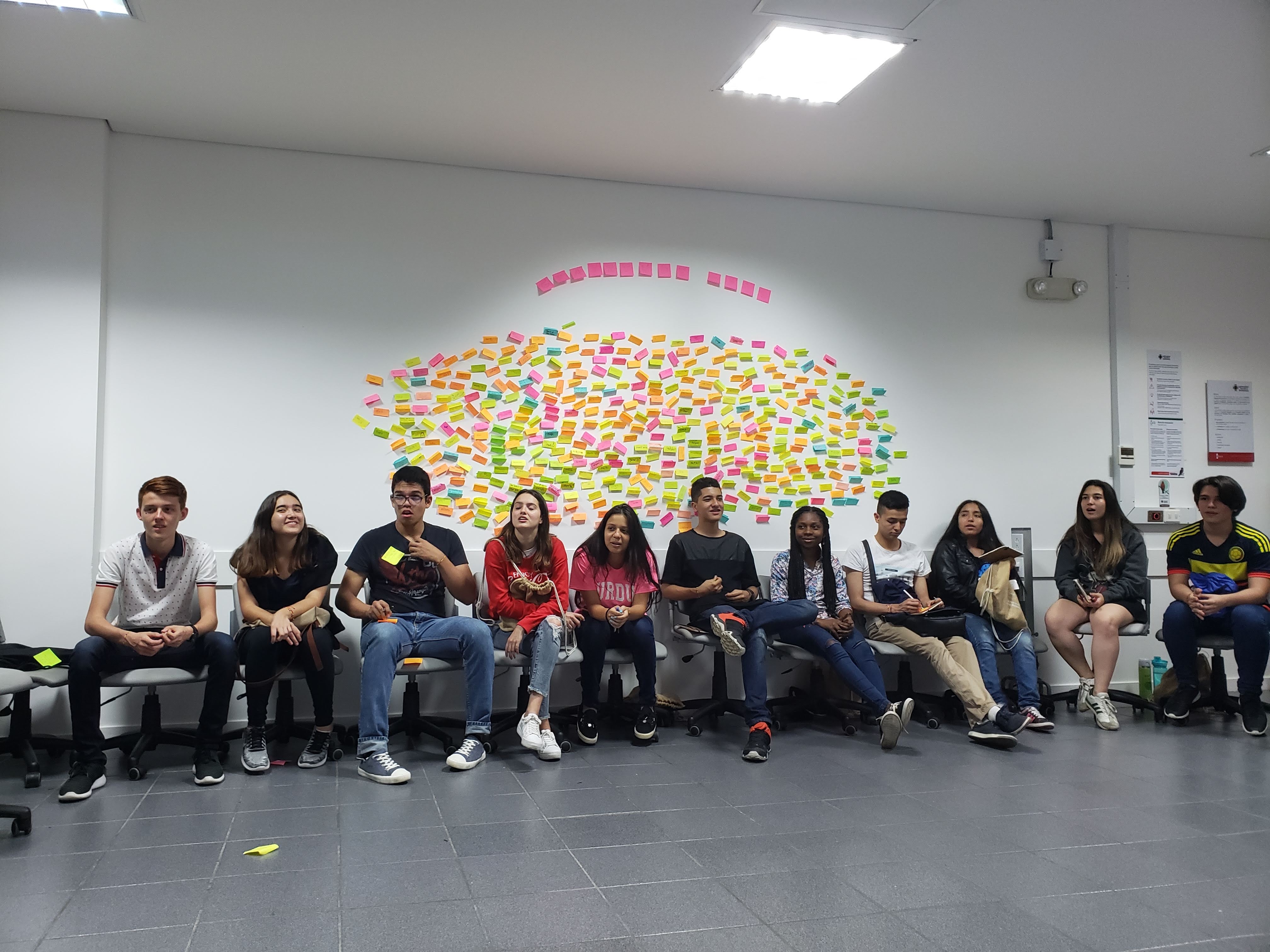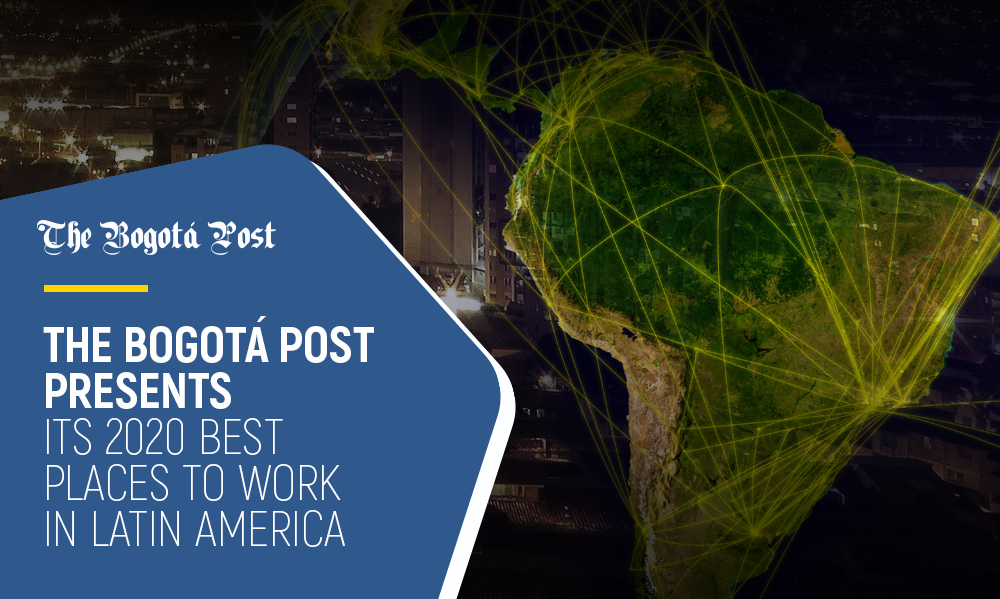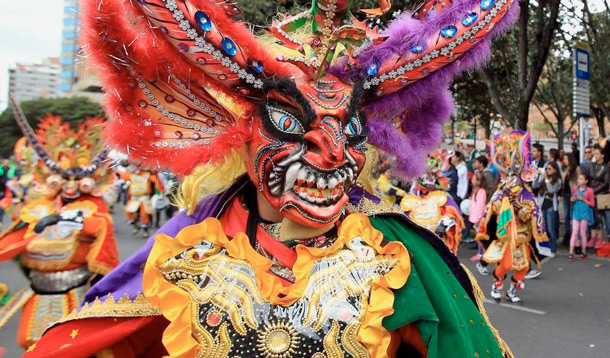 On August 6, Bogota celebrated its 477th birthday and since it is a long wait until the city hits the big 500, we thought it was a good time to go Bogo-tastic and say happy birthday Bogota!
On August 6, Bogota celebrated its 477th birthday and since it is a long wait until the city hits the big 500, we thought it was a good time to go Bogo-tastic and say happy birthday Bogota!
The city celebrated in style, kicking off the festivities with a huge concert in the Plaza de Bolívar, featuring the novel combination of Puerto Candelaria performing with the Bogota Philharmonic Orchestra, prior to fireworks exploding over the Torre Colpatria.
Cycle fans were also able to make the most of the Ciclovia nocturna, pedalling around the capital in decidedly cooler temperatures.
A fantastic sensory carnival took over the Septima on August 9 – featuring three “guest” carnival performers: Pasto’s Blancos y Negros, spicey Barranquilla dancers and a delegation from Bolivia’s largest carnival in Oruro.
Usaquen, Chapinero and Teusaquillo also exploded into life, with each barrio hosting street parades, live music and local dance and theatre groups.
So even if you missed the city’s celebrations, delve into The Bogota Post’s top free attractions, fantastic photos, a love letter to the city and a quick historical run-down of Colombia’s diverse capital, 2,640m closer to the stars!
More than 2,000 artists and performers of different ethnic groups and populations were part of the parade to celebrate Bogota’s 477 years.
Photos: Laura Brinkley & Mauricio Dueñas Castañeda
A brief history of Bogota
Juan Camilo Palacio traces the city’s growth from humble beginnings, right up to the metropolis Bogota is today
Bogota, once home to the Zipa and Zaque tribes in the lowland Savannah plains surrounding the city, is known for it’s Muisca indigenous heritage. The city has certainly come a long way since the Spanish conquistador, Gonzalo Jimenez de Quesada first established a settlement of 12 wooden huts in 1538.
There’s a number of stories about how Bogota got its name and the exact location of the city’s birthplace – though many say it was the Chorro de Quevedo. That same square on Calle 13 with 2a is now home to a replica of Bogota’s first church – Capilla del Humilladero. The oldest surviving church in the capital is La Iglesia de San Francisco, built by Franciscan monks between 1550 and 1567.
Others contest that the city was in fact created in Plaza de Bolívar, initially the site of wooden stocks which the Spanish conquistadors used for public trials and humiliation.
From its unlikely rise as the seat of the Spanish-controlled kingdom of New Granada during the 16th century –beating Cartagena, Mompox and Tunja– Bogota remained a thriving capital of the viceroyalty of Nueva Granada during the 18th century: before Colombian independence a century later.
The Spanish colonists heavily influenced the city that we see today – the architecture in the Candelaria, the grid system that follows the Spanish city planning rules, with carreras and calles emanating from a central square, and of course, the many churches that dominate the cityscape.
Bogota played a leading role in the story of Colombia’s struggle for liberty; many other departments had declared independence, but it is the day of July 20, 1810 – when the citizens of Bogota made their proclamation – that is celebrated as Independence Day.
And then of course the conclusive Battle of Boyaca nine years later when Bolívar reclaimed the city for good.
Independence gave birth to Gran Colombia, a state which encompassed a large section of Central and South America from 1819 to 1831, during which time the capital moved around the country. Yet Bogota once again regained its crown in 1821.
When Gran Colombia gave way to the Republic of New Granada in 1831, Bogota became the seat of government for the republic. The city’s rise and fall is firmly linked to that of the country: with violence playing a shaping role.
Bogota mushroomed to five times its size after the bloody Thousand Days’ War, between Liberal and Conservative supporters. The city’s infamous Bogotazo in 1948, provoked by the assassination of presidential candidate Jorge Eliécer Gaitán, resulted in the city being burnt to the ground, with over 5,000 people killed as a result of fighting between the warring political parties.
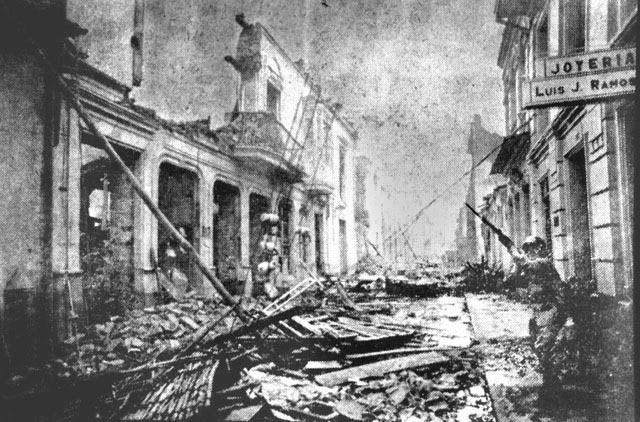
A scene of destruction after the Bogotazo in 1948.
Many historians put El Bogotazo as the start of La Violencia, ten years of civil war that left nearly 200,000 dead nationwide and gave birth to many of the problems Colombia has faced in the subsequent 50 years.
The difficult decade led to General Rojas’ dictatorship, which ended with a public coup d’etat in 1957. But both the country – and city – would still have a tough road to travel to the present day.
With a swift move from party-led violence to guerrilla fighting, and tough new anti-drug legislation, the city experienced a new wave of migrants. Desplazados arrived in waves during the 1970s, escaping from rural violence. Mass migration started a process of impoverishment, resulting in disorganised, yet exponential, growth.
With the new constitution drawn up in the early 90s and the opportunity for larger democratisation, Bogota had a welcome new start. The city was awarded special status as a district, and a stream of successful governments created what at the time was a textbook success story. It was also the time yours truly, and many others, arrived in this updated, safer and prouder Bogota.
The subsequent economic slump took some of the shine off Bogota’s previous polish, causing a deteriorated perception both of security and the opportunities that the city could provide. But as at so many other points in its history, Bogota came back fighting and the city’s economy was soon the fastest growing in Latin America.
Bogota has faced a bumpy road, developing into the chaotic, yet welcoming, metropolis it is today. A city where rolos, Colombians from other regions and foreigners alike, converge to become locals in their own right.
As times continue to change, with peace hopefully in the pipeline, the city could soon undergo a new transformation.
Interested in finding out more? The Museum of Independence, home to a vase which played an important role in Colombia’s history, and the Museo Nacional, are just some of the places which will help you find out more about the history of this diverse, vibrant city.
Free Bogota
Dan Haddow explores some of the best options for things to do for free in the city
Leave Bogota and all you hear about the capital is that it’s cold and it’s too expensive. While this little guide can’t claim to have any significant impact on the weather, it will certainly confound the haters who claim you need mucho billete to enjoy a nice day out in the D.C.
Monserrate
Many people are struck by Bogota’s concentrated urbanisation but a quick glance at the eastern mountains reminds you that the city is surrounded by nature. Instead of spending COP $17,000 to be transported up and down the iconic Monserrate mountain by cable car, why not brave the stairs? Avoid the Sunday pilgrimage and you’ll be able to enjoy fabulous views of the city stretching out below all to yourself.
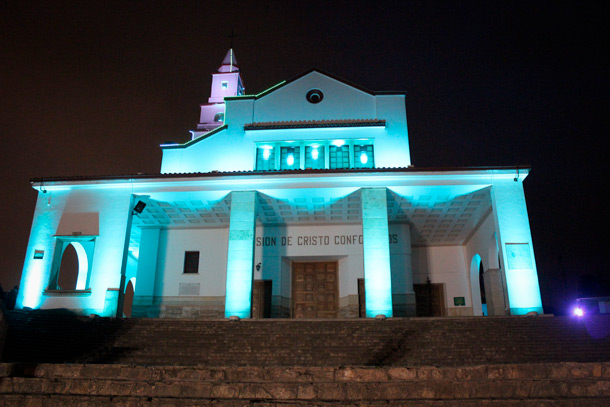
Monserrate church lit up at night, one of Bogota’s most famous landmarks. Photo: Chantelle du Plessis
Virgilio Barco Library
Set amid a beautiful green space that forms part of the monstrous Parque Simon Bolivar, the Virgilio Barco Library invites visitors to explore its archives or just hang out and read in many of its thoughtfully-designed spaces. Built into a dip which obscures all but the highest towers and provides an unobstructed vista of the mountains, Virgilio Barco is a cool place to disconnect from the city without having to leave it.
Ciclovía
With 120km of road set aside and over a million people participating on a weekly basis, Ciclovía is one of the standout successes of Bogota’s efforts to make the city a more attractive place to live. Some ride, some run, others walk and others skate or push prams, yet all come together to blow off steam on Sundays, public holidays and a smattering of one-off events like the recent Ciclovía Nocturna and El Día sin Carro.
Ciclopaseos
Sticking with the topic, if cycling is your thing then it’s time to make the acquaintance of fellow fanatics. Check out Ciclopaseo Cachaco, Concienbiciate and Sucicla paseos on Facebook for more details on upcoming rides, meets and gatherings among the urban cycling community.
Un Techo Para Mi Pais
If you are keen to get involved with some meaningful social work then look no further than Un Techo Para Mi Pais. Techo is a student-led foundation that relies on the collaboration of volunteers to meet the demands of its ambitious social projects. Introductory chats are held every Wednesday at 6pm in the foundation’s Teusaquillo head office.
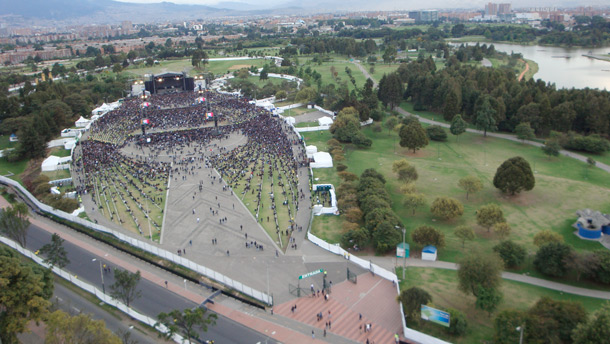
Parque Simón Bolívar and its giant open air amphitheatre.
Visit the parks
Parque Nacional, Parque Simón Bolívar, Parque de los Novios and the Jardín Botánico are some of the countless green spaces, dotted amid the concrete jungle, that offer visitors a chance to unwind. Simón Bolívar has a 3km running track that curls around a giant lake where you can feed the ducks or rent a pedalo.
Parque Nacional gives you a true sense of what Bogota was like before urbanisation, with tall, swaying trees, burbling streams and countless bird species living together in harmony only a stone’s throw from the city’s most important artery; and if you’re into longboarding this is where the crew hangs out most days and races down the hill.
Graffiti tour
One of the first things people notice in Bogota is that its walls, doors, windows and public spaces are completely tagged out. The sheer quantity of graffiti has pushed artists to create higher quality pieces with only the best remaining standing. Testament to this was when Justin Bieber’s Calle 26 piece was righteously sprayed over before the paint had even finished drying. For way more info on Bogota’s thriving graffiti scene get in touch: http://bogotagraffiti.com/ for English-spoken graffiti tours. The tours are not exactly free, since they invite you to pay what you think they are worth – and you’re likely to enjoy it and think it is worth compensation.
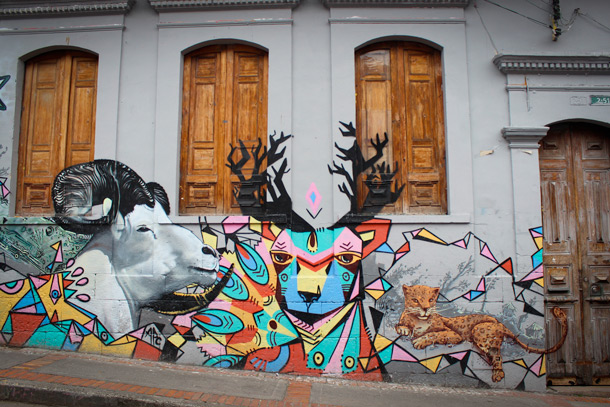
One of the many stops along the popular Graffiti tour in La Candelaria. Photo: Chantelle du Plessis
Country walks
Quebrada La Vieja, which embarks from Rosales and is well-policed and protected, offers walkers a fairly challenging countryside hike along paths that cross giant boulders, rushing streams and pine-carpeted woodland. Best to go early in the morning as the trail is only open from 5-10am. For information on upcoming walks visit the proximas caminatas on caminobogotano.wordpress.com.
“*****” al Parque concerts
Insert your favourite music genre into the above space and unless it’s obscure Russian folklore-inspired-contemporary-baroque music then it probably has a free open-air concert during the year. Popular editions include Rock al Parque, Salsa al Parque and Hip-hop al Parque. Check out http://festivalesalparque.gov.co/ for more info.
Free walking tours
Bogota Bike Tours offers free walking trips around the city on Tuesdays, Thursdays and Saturdays at 2pm from their office on Carrera 3 #12-72. Check out their website for more info. They bring the same style and magic touch that the popular bike tours are famed for to the two-footed variety, getting you up close and personal with La Candelaria.
The local tourism office also offers complimentary ‘sightseeing walking tours’, every day at 10am and 2pm, English language tours on Wednesdays and Thursdays. They depart from the information point on the corner of Plaza Bolívar, and you have to let them know you are coming in advance. The quality of the English guides varies, but they are well trained and full of tit bits such as the stories behind various Colombian banknotes and the many tales from the city’s numerous buildings.
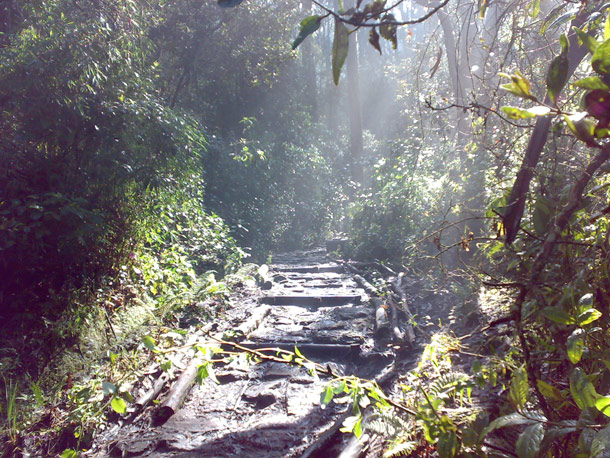
Feel like getting back to nature? Take a hike up Quebrada La Vieja.
Museums
Don’t forget that many of the city’s top museums are free – such as the Museo Botero, worth a peek both for the wide selection of paintings and sculptures and the building itself. The permanent exhibition in the Museo Nacional is also free – and the former prison is another building that is interesting to visit in its own right. Well worth a visit is the free Museo Histórico de la Policía Nacional, even home to the jacket that Pablo Escobar was shot in. You can have a free tour from a very happy to help police cadet – and the view from the roof is fantastic for photographs!
A number of other museums such as the Museo del Oro and the Museo de la Independencia are free on Sundays.
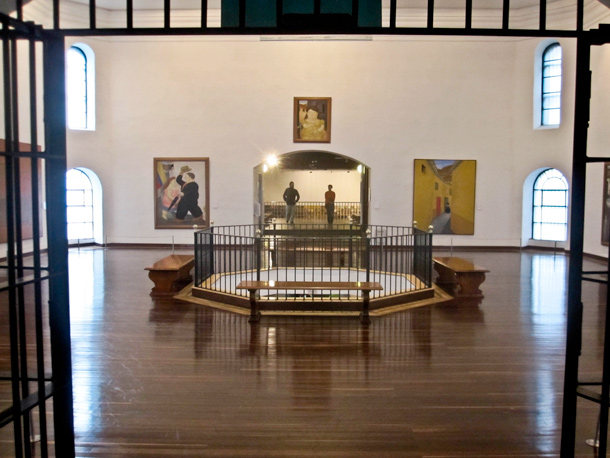
An inside view of one of the many spaces within the Museo Nacional.
A portrait of Bogota
All Photos by Christian Willner
A paisa ‘love letter’ to Bogota
Leaving Medellin behind over a decade ago was not easy for Margarita Pombo, but in Bogota she found a city she’d grow to love in a strange kind of way
From Medellin to Rionegro airport it’s about a 40km ride. Yet when you’re leaving the city forever, it feels as if you’re in a DeLorean travelling through your whole life, and the 40km pass by in a heartbeat.
All I had heard was, “How can you leave Medellin?” “How can you leave this climate, the lovely people, and the clean, organised city?” “How is it possible to leave the eternal spring behind for Bogota?”
I couldn’t get my head round it either, but still I arrived in the capital, after litres of tears, dozens of leaving cards and plenty of wine-soaked stories.
Standing in the middle of Septima, I had no idea which way was north and which was south. At night, it was so cold I had to sleep in pyjama trousers, a long-sleeved t-shirt, socks and three blankets (those heavy ones you get tired just moving). I even ate with my jacket still on. Every couple of blocks I had to ask where such-and-such a place was, all the while feeling as if I was in the Babel of accents.
When you arrive in the capital, you learn to differentiate between the costeño accent of Barranquilla and Cartagena, you discover that a guajiro speaks more slowly but with some weird words, you feast on a caldo de costilla after an all-night party, at the hairdresser you ask them to give you a blower and you need a bricket to light your fag.
Twelve years ago, in the Athens of South America, we partied hard with Maldita Primavera, Pandora and Daniela Romo and I, like any good stranger, looked down my nose at people because we have a metro, because I was 20 centimetres taller than everybody, because everything that anybody said ended up sounding like a question, because, in the capital of marica guevon and other roladas, the raison-d’être of any outsider is to bully the locals.
What I know now is that they take it because rolos are like that – patient, extremely diplomatic, kind and refined. So much so that, years later, after bullying half the city, I felt like Rosario Tijeras, cursing every pothole, every sneaky bollard, every freezing night and every torrential downpour.
And now, 12 years later, I can cross the city without getting carsick, I always carry an umbrella in my handbag, I know how to wear a scarf in four different ways, I have costeño friends, hang out with posh rolos, I’ve discovered that people from Santander aren’t bad-tempered, but simply horny, Huilenses live their lives at 16 RPM and the llaneros have fincas that I’d like to be invited to every puente.
I became patient and even accept the bullying I receive when people visit me from other cities.
At the end of the day, Bogota is like my husband – a bit tiresome, not that handsome and quite annoying at times. Medellin, my lover, is more stunning every time I visit, as I lustfully ogle him. But when I remember all that Bogota has given me, I tell myself: ‘You shouldn’t leave your husband for your lover.’

